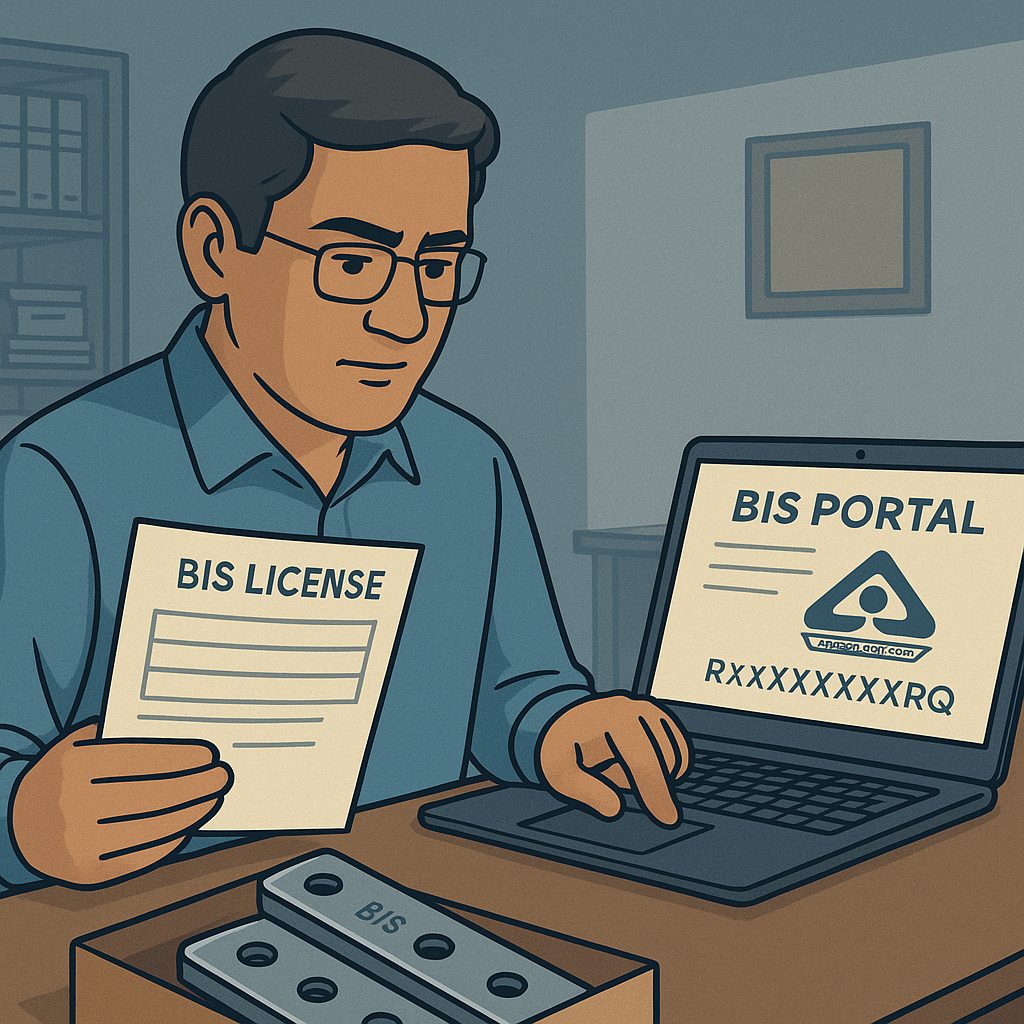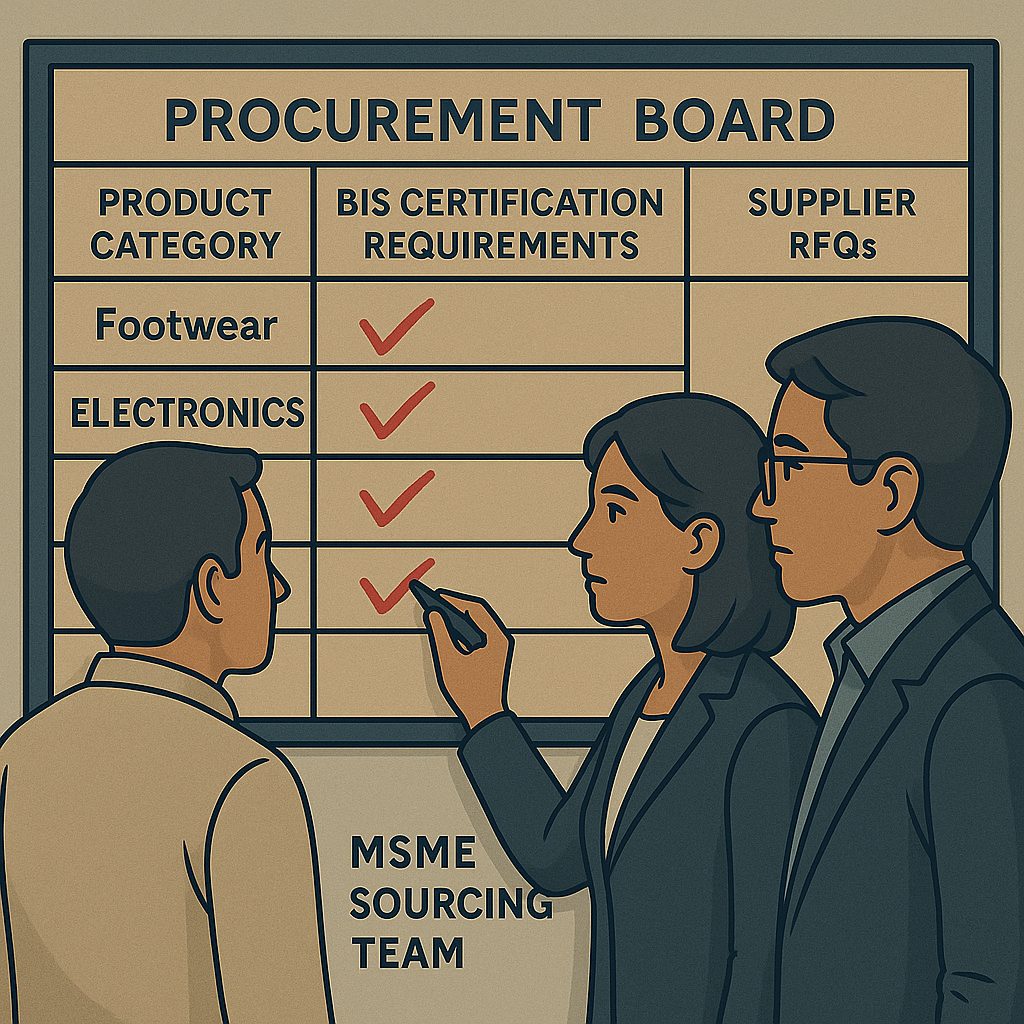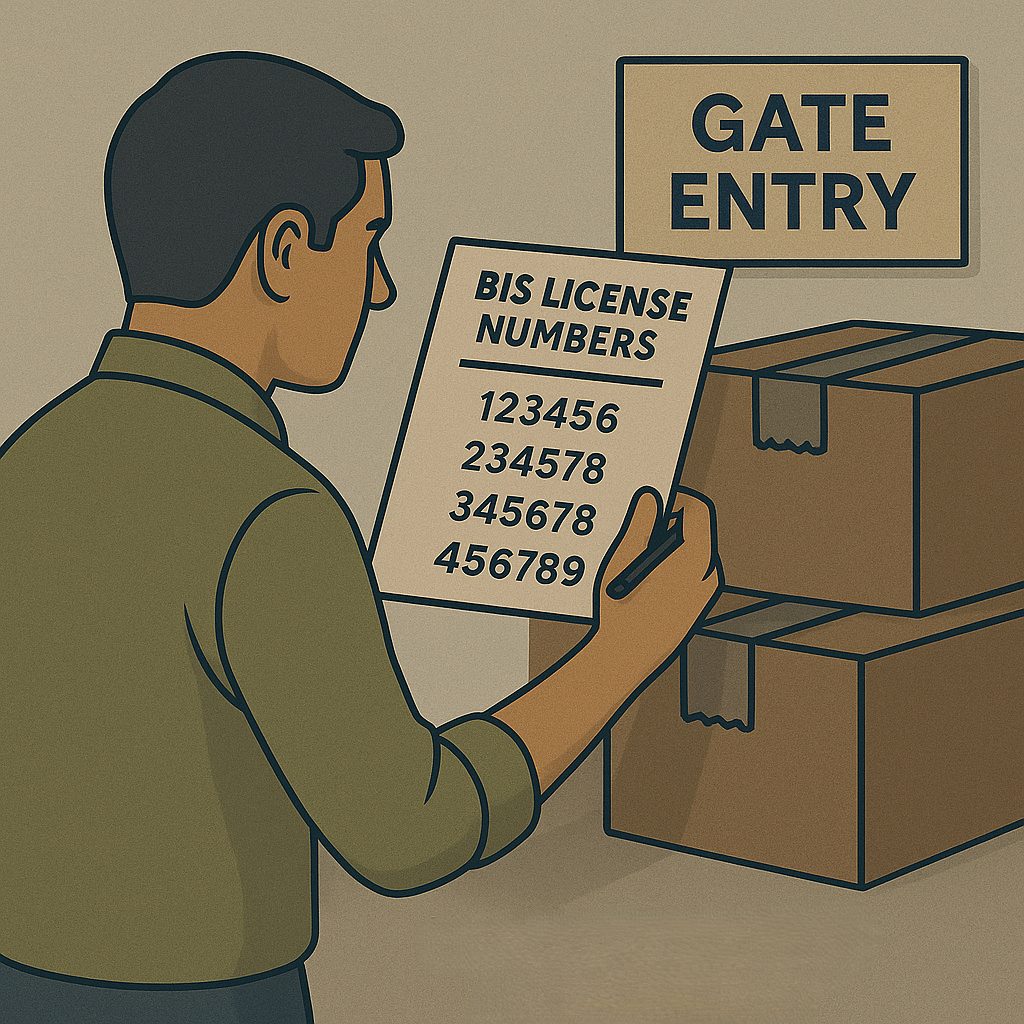Table of Contents
- Introduction
- What Are BIS Markings and Why They Matter in Procurement
- Key MSME Challenges Around BIS Markings
- Mapping BIS Markings to Product Categories
- How MSMEs Can Integrate BIS Checks into Procurement Workflows
- Cost and Risk Management with BIS Markings
- Practical Next Steps for MSME Sourcing Teams
- Conclusion
Every MSME buyer in India knows the pain of receiving a shipment that looks fine on the invoice but collapses under inspection. The goods are cheaper, but the paperwork is incomplete, or the certification is missing. Dispatches stall, tenders slip away, and the cash locked in that order sits idle.
BIS markings are meant to prevent exactly this. They indicate that the Bureau of Indian Standards has checked the product against safety and quality rules. Footwear, toys, electronics, even heavy machinery now fall under these requirements. A consignment without the right mark may not even cross the warehouse gate of a large buyer or a government department.
Too often, MSMEs treat BIS markings as a formality. That mistake is costly. A rejected delivery can wipe out margin, add freight charges, and strain supplier relations. Procurement teams that integrate BIS checks into sourcing decisions avoid these traps. They cut waste, build stronger vendor lists, and stay tender-ready when large contracts open up.
What Are BIS Markings and Why They Matter in Procurement
BIS markings exist to separate certified products from uncertified ones. The ISI mark is the most visible on industrial goods. Electronics and IT items are cleared under the Compulsory Registration Scheme. Jewellery requires hallmarking with a HUID code. Each of these markings points back to a license issued by the Bureau of Indian Standards.
In procurement, the presence or absence of that mark decides whether a shipment moves or stalls. A missing BIS certificate can hold up goods at customs, stop payment on an invoice, or cause rejection in a government order. MSMEs often realise this only after a consignment is stuck and working capital is frozen. The financial impact is immediate.
The common mistake is surface-level checking. Buyers look at a logo but do not verify the license number. Vendors sometimes paste a fake mark on packaging, and the goods pass through until an audit catches the mismatch. At that stage, the buyer is left with unusable stock and no room to claim damages.
The better practice is to make BIS markings part of vendor screening. Ask for the license copy before issuing the purchase order. Match the details on the BIS database. Build this step into the procurement workflow, not afterthought. This habit saves margin, protects vendor credibility, and reduces disputes that drain time from MSME teams already stretched thin.
Key MSME Challenges Around BIS Markings
BIS markings are meant to protect buyers. In reality, many MSMEs run into problems when they try to work with them. These problems are rarely about definitions. They show up in supply chains, invoices, and inspections.
Paperwork that fails at audit
A supplier sends cartons with the BIS logo. On the invoice, the license number is either missing or outdated. Auditors stop the file. Payment does not move. Stock sits in the warehouse with no clearance. For a small unit, even two weeks of blocked cash can choke daily operations.
Certification that takes too long
For some machines, especially under Scheme-X, the approval process stretches close to a year. Buyers who do not build this lead time into their plan end up with idle capacity. The machine is paid for, but cannot be used. Orders get delayed, contracts slip, credibility suffers.
Costs pushed onto buyers
Testing and renewal charges add up. Vendors recover these expenses through higher quotations. The difference may look minor — two or three percent — but in a close tender that margin decides the winner. MSMEs already work on thin spreads. That extra compliance cost is enough to turn a project unviable.
Vendors cutting corners
Not every supplier keeps all product lines certified. Some only maintain licenses for high-volume items. The rest still carry the mark on packaging, but without valid backing. If the buyer fails to check, uncertified stock enters the system. In government contracts, one such delivery is enough to lose eligibility for future tenders.
These are not minor issues. They translate into stuck capital, missed schedules, and damaged trust with large buyers. For MSMEs, the impact is direct and heavy. A single failed consignment can wipe out the profit of an entire quarter.
Mapping BIS Markings to Product Categories
Different industries fall under different BIS requirements. For MSMEs, the challenge is knowing which category matters to their supply chain and how the rules change. Missing this mapping is where most mistakes begin.
Footwear and consumer goods
Since October 2025, footwear must carry an ISI mark. Small shoemakers have struggled because certification needs lab tests and upfront fees. One cluster in Agra reported consignments rejected at retail warehouses because cartons lacked proper BIS markings. Even where rebates exist for micro and small units, most firms do not know how to claim them.
Industrial machinery
Pumps, cranes, and packaging units now fall under the Scheme-X framework. The lead time is long — often close to a year. An MSME buying a pump for a new production line cannot use it until certification clears. A Ludhiana unit faced this exact problem: machinery was delivered but remained idle for months because the BIS license had not been issued. The cost of downtime exceeded the cost of the equipment.
Electronics and IT hardware
Any MSME importing electronics must comply with the Compulsory Registration Scheme (CRS). Without it, shipments get stuck at customs. A Kolkata trader bringing in power adapters faced heavy demurrage fees because CRS documentation was missing. The goods were genuine, but the paperwork was incomplete.
Jewellery and hallmarking
Gold and silver now require hallmarking with HUID codes. This is not optional. MSMEs dealing in ornaments who skip this step see stock returned or flagged as non-compliant. A Jaipur jeweller lost a government supply order because only half the items carried valid HUIDs, even though every piece had a purity stamp.
The point is simple: each product category has its own BIS rulebook. Procurement teams that do not align orders to these requirements invite risk. The mark is not decorative. It decides whether goods can be sold, shipped, or even accepted by buyers.
How MSMEs Can Integrate BIS Checks into Procurement Workflows
The problem most MSMEs face is not ignorance. It is late checking. Certification gets looked at after the order is placed, sometimes after goods arrive. By then, it is too late. Payments stall, auditors raise queries, and buyers lose leverage.
Put it in the RFQ
If the request for quotation does not demand BIS details, vendors will skip them. Add one line: “Valid BIS license copy with quotation.” This forces the proof upfront. Vendors who cannot supply it can be filtered before price negotiations even start.
Check the license before signing
Do not rely on a vendor’s word. Ask for the license document. Cross-check it on the BIS portal. If the number does not show or the license has expired, do not issue the purchase order. This takes less time than chasing compliance later.
Verify cartons and invoices on arrival
Logos are easy to copy. Procurement officers should match the mark on cartons with the license on the invoice. If there is no alignment, stop the consignment then and there. Waiting until an audit will only block cash and add penalties.
Keep a simple tracker
It does not need software. A spreadsheet with vendor name, license number, and expiry date works. Teams that skip this end up depending on memory. One expired license in a high-value delivery can wipe out a tender opportunity.
BIS checks are not red tape when done early. They are guardrails. Skipping them costs MSMEs more in lost orders and stuck cash than it does to verify them at the right stage.
Cost and Risk Management with BIS Markings
BIS compliance always comes with a price tag. Testing fees, inspection charges, and renewals all get pushed into supplier quotes. For small enterprises, ignoring this cost leads to wrong comparisons. The cheapest offer on paper may not be the cheapest once certification is added back in.
Budgeting for hidden expenses
Many MSMEs only budget for unit price and transport. They forget lab tests, audit visits, and renewal fees. When suppliers pass on these costs, the margin shrinks. Procurement heads who build these numbers into early negotiations keep control. Those who don’t end up explaining cost overruns later.
Rebates that go unused
Rebate schemes exist — 80% for micro, 50% for small, 20% for medium in some categories like footwear. But most units don’t apply, or apply too late. The money is left on the table. Proper planning means factoring rebates into sourcing strategy, not treating them as an afterthought.
Penalties for getting it wrong
One uncertified delivery can create more damage than the savings from cutting corners. Stock can be seized, tenders cancelled, or consignments returned. For a small manufacturer, that’s not just a financial hit, it’s a reputation issue. Buyers do not easily trust a supplier who has already failed compliance once.
Risk of counterfeit marks
The market is full of products carrying fake ISI or CRS marks. If procurement accepts them without verification, the liability shifts to the buyer. Audits will not spare an MSME because the vendor printed a fake logo. Checking the license against the BIS database is the only safeguard.
The lesson is straightforward. Certification costs should be treated as part of the landed price. Risks should be calculated in real terms — stuck cash, lost tenders, damaged credibility. MSMEs that take BIS markings seriously spend a little more up front but avoid heavy losses later.
Practical Next Steps for MSME Sourcing Teams
BIS checks cannot sit outside procurement. If they do, problems will keep repeating. The fixes are simple but need discipline.
Make a short checklist
Four things to confirm before any payment: valid license copy, number checked on the BIS portal, invoice match, and carton mark. Miss one and cash gets stuck.
Keep vendor files updated
Every supplier should have a record — license numbers, expiry dates, and categories covered. A folder or a shared sheet is enough. Without this, teams scramble when an auditor asks questions.
Watch the gate
The first check happens at entry, not in the audit room. Train security or stores staff to look for the mark and match it with the invoice. Reject goods on the spot if details don’t align.
Lock compliance into the contract
Purchase orders must carry a clear clause: uncertified stock will not be accepted, cost falls back on the vendor. Without this, the risk sits with the buyer.
Do not waste rebates
Government gives rebates on certification costs, but many MSMEs never apply. Track the schemes, file on time. Small margins matter when working capital is thin.
BIS markings are not extra work. They are protection. Each step done early saves weeks of chasing later. For small units, that difference decides whether a contract runs smoothly or collapses under disputes.
Conclusion
BIS markings are not decoration. They decide whether stock is accepted or turned away. They affect tenders, audits, and trust. When ignored, the result is stuck money and broken supply lines.
The fix is not complicated. Check the license before placing an order. Match the number when goods arrive. Keep expiry dates on file. Put a line in every contract that uncertified stock will be rejected at vendor cost. Apply for rebates on time.
These are small actions, but they prevent heavy losses. For an MSME, avoiding one rejected consignment can protect an entire quarter’s profit. BIS is not paperwork — it is protection, and it belongs at the core of procurement.
Looking to procure steel?
Tata nexarc helps manufacturers, builders and MSMEs source certified steel products, compare prices, and choose the right grade as per IS codes—with complete traceability and procurement confidence.
FAQs
Can an MSME buyer be penalized for accepting goods without BIS marking?
How can MSMEs verify whether a BIS license number is genuine?
Are BIS markings required for imported raw materials?
What happens if a supplier’s BIS license expires mid-contract?
Do BIS certifications differ between domestic and export supplies?
Can BIS markings be applied retroactively to stock already in warehouses?
What is the role of BIS-recognized labs in procurement checks?
Do micro and small units get financial relief for BIS compliance?
How should RFQs handle BIS requirements for multi-category orders?
What red flags signal fake BIS markings during inspections?
Ananya Mittal blends a background in data science with a passion for writing, contributing to Tata Nexarc’s efforts in creating insightful, data-informed content for MSMEs. Her work focuses on exploring sector-specific challenges and opportunities across procurement, logistics, and business strategy. She is also involved in leveraging analytics to strengthen content performance and deliver actionable insights to India's growing B2B ecosystem.












